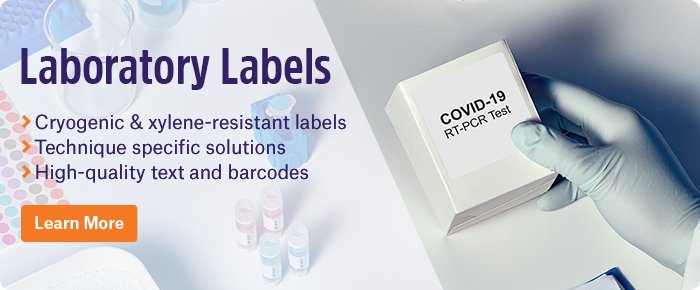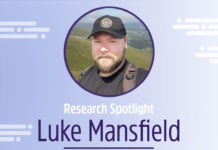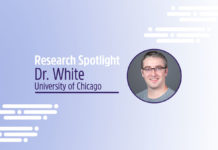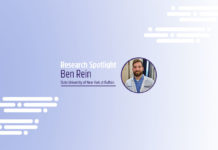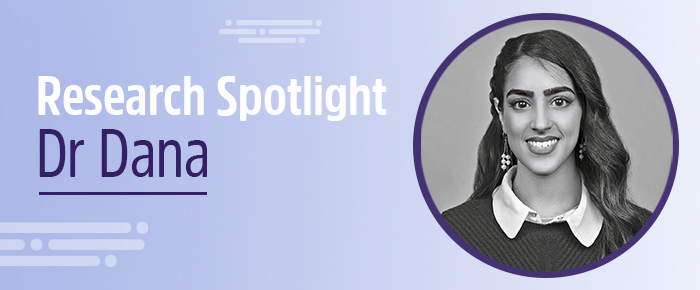
Our latest research spotlight focuses on the young, accomplished, and up-and-coming Dr. Dana Al-Sulaiman, a biomedical engineer developing biosensing platforms and technologies for the early detection of cancer biomarkers. Her studies have taken her all over the world, and she hopes to return home to start her own research group studying the field of biosensing materials for healthcare applications.
Dr. Al-Sulaiman’s background and early training
Dr. Al-Sulaiman’s passion for science and scientific inquiry flourished when she moved to Canada from her home country to attend high school. This is where she first discovered the field of biomedical engineering. She would later move to the UK in 2015 to pursue her undergraduate studies in this discipline at the Imperial College of London.
During her time as a Ph.D. student, Dr. Al-Sulaiman was an avid teaching assistant and was involved in outreach, receiving a medal at the 2015 STEM for Britain national competition held at the House of Commons. In 2019, she would go on to join the Doyle group in the Chemical Engineering department at MIT, where she focused on developing next-generation biosensors that combine microtechnologies and biomaterials for cancer diagnosis, prognosis, and monitoring. In recognition of her contributions to the field of biomedical engineering, she was awarded the Institute of Engineering and Technology (IET) Healthcare technologies award (William James Category) that same year.
“I came out top of my cohort and was awarded the Imperial College President’s Ph.D. Scholarship to support my doctoral studies. The aim of my research was to enable earlier and better diagnostic and prognostic tests for cancer, ideally from ‘liquid biopsies’ as opposed to traditional invasive tissue biopsies.”
Dr. Al-Sulaiman was inspired by the dedication and compassion of her great aunt, a prominent pediatrician in her home country, to contribute to the field of healthcare. Growing up, she has experienced first-hand the heavy cost cancer can exert on families, having had many loved ones fall victim to cancer. This is one reason she chose to focus her research efforts on reducing the burden of this deadly disease.
“Throughout my undergraduate research, I learned that one way to significantly impact cancer patients’ lives and increase survival is by improving cancer diagnostics and monitoring, particularly through early disease detection. Midway through my Ph.D., my father was diagnosed with stage III colon cancer, and his strength and perseverance during his treatment continue to motivate me to contribute to this field every day.”
The field of cancer diagnostics and liquid biopsies
Her research currently focuses on developing biosensing platforms and technologies to detect highly promising nucleic acid biomarkers, namely microRNA, for the purposes of cancer diagnosis, prognosis, and monitoring. Her postdoctoral research at the Massachusetts Institute of Technology (MIT) has focused on developing assays for multiplexed and point-of-care detection of cancer from liquid biopsies such as from blood or skin interstitial fluid. These assays are designed to be simple, quick, and low-cost.
“Depending on the biomarker detected within the biological fluid, liquid biopsies could potentially change the way cancer is detected, managed, and treated. Liquid biopsies could be used to detect disease at its earliest stages, monitor disease progression, or monitor a patient’s response to therapy.”
Liquid biopsies represent a promising new tool for personalized medicine and early disease detection. They can become a less invasive alternative to the standard tissue biopsy, which is currently the gold standard method used to diagnose cancer. Instead of undergoing an invasive surgery which may result in further health complications, a patient would only need to provide a biological fluid sample like blood, urine, or saliva. The detection of disease biomarkers within the sample could then be used to inform clinical decisions in a faster, more accurate, and less invasive manner.
Not only could liquid biopsies increase patient compliance, but they could also be used to monitor disease progression as they can be taken repeatedly over time. Today, tissue biopsies still represent the best way to diagnose cancer reliably, though liquid biopsies have the potential to replace this invasive strategy in cases where sensitive and specific biomarkers have been validated clinically or when sensitive, robust, and reliable tests have been developed and approved.
“This field is rapidly expanding and developing, and I believe it will be able to transform clinical oncology in the near future. At present, liquid biopsies are being used in the clinic as companion diagnostics to help match patients to the most effective treatment or therapy plan. I believe there will be an increased adoption of and reliance on liquid biopsies in clinical oncology, especially with the increasing drive towards personalized medicine. As we’ve seen with COVID-19, PCR tests relying on liquid biopsies through nasopharyngeal swabs have significantly transformed public screening.”
Tumor heterogeneity and the future of spatial diagnostics
Dr. Al-Sulaiman is also working on developing technologies that can quantify tumor heterogeneity to enable more personalized and effective treatment plans, thus addressing a major challenge in clinical oncology. Tumor heterogeneity represents one of the main challenges facing cancer diagnosis and monitoring. Intratumoral heterogeneity is a phenomenon where individual tumor cells exhibit different phenotypic, morphological, and gene expression profiles. This variability has significant clinical implications; for example, pre-treatment heterogeneity can make it challenging to classify patients for specific or targeted therapies, while post-treatment heterogeneity can lead to the development of resistant clones and potentially more aggressive cancers.
“Developing technologies that can probe cancer heterogeneity through spatially-resolved biomarker profiling can enable a better understanding of the tumor microenvironment and can guide clinical decisions in selecting more effective and personalized therapies.”
Spatial diagnostics requires the use of an intact tissue specimen, for example, a tumor section where the spatial organization and architecture of the tumor and its microenvironment are maintained. On the other hand, liquid biopsies require the use of a biofluid sample, into which molecules and biomarkers have been released by the tumor and its microenvironment. Since these two types of tests rely on different biological sources, they could answer different questions regarding the disease, and the combination of both could provide clinicians with the information to make more accurate clinical decisions. This will require, however, the use of different platforms or devices engineered to achieve different goals.
Having just turned 28, Dr. Al-Sulaiman is excited to move back home to the Middle East to continue her career in academia, where she has secured a faculty position at King Abdullah University for Science and Technology (KAUST). She is currently recruiting graduate students and postdocs to assemble her research group dedicated to studying the field of biosensing materials and their applications in healthcare. She is looking forward to receiving and reviewing applications from passionate scientists or interested collaborators who wish to be part of cutting-edge research tackling some of the major healthcare problems facing our society today.
“My goal is to continue research in the field of disease diagnosis and monitoring for cancer and neurodegenerative diseases like Alzheimer’s disease. I am also interested in studying the skin, to probe biomarkers in the skin interstitial fluid, and to understand the skin microbiome and its biological role.”
Dr Al-Sulaiman’s contact details:
Email: danasul@mit.edu; danasul7@gmail.com
LabTAG by GA International is a leading manufacturer of high-performance specialty labels and a supplier of identification solutions used in research and medical labs as well as healthcare institutions.

